Earthquake retrofitting is an extensive field, and those involved in it have a wide range of specialties. While some focus on structural issues, others focus on the physical safety of the building or home itself. There are different approaches to take when retrofitting buildings to make them more resistant to future disasters such as earthquakes. This may mean that there are different kinds of services that are needed for the retrofitting process.
The main focus of retrofitting contractors is to design buildings or homes that can better withstand natural disasters. They use a variety of strategies to ensure that the building’s integrity is not threatened. These strategies include testing, evaluating, and re-testing materials and structures in order to determine if any have been weakened or affected in some way.
When a building experiences an earthquake, many things can go wrong. Faulty foundations can be a contributing factor, as can poor maintenance and the settling of the land. In cases such as these, the retrofitting process is the only option. Contractors will hire professional engineers and architects to help design and create a building that will better withstand any disaster. The retrofitting contractors will then work with them to set up the building for its proper installation.
The first step is inspection. It is important to have a qualified and skilled team evaluate any building that is considered to be at risk for a disaster. A qualified team will include an engineer who specializes in structural issues and one who specializes in geotechnical issues. They will assess the site’s soil conditions and analyze the potential of buried strong undertones, which can weaken buildings.
After the initial inspection, the team will begin the process of evaluating the building. This involves looking into the possibilities of weakening or damaging the building due to natural disasters, as well as the effects that human error or negligence can have. These factors will play a role in the quality of the materials used, the quality of construction, and the ultimate performance and longevity of the building. The goal of the entire process is to make sure that the earthquake retrofitting is as effective as possible.
The second phase is maintenance. Contractors will continue to check on the integrity and the performance of the building, making sure that it is as strong as it can be. Over time, earthquakes will cause a lot of damage and structural failure, but the retrofitting contractors will use quality materials to strengthen the building structure and systems, as well as keeping it safe and sound. By using good materials, earthquake damage will not be able to take place.
Finally, retrofitting should not stop once the original construction has been completed. If a disaster were ever to occur, the retrofitting team should continue to fix the weaknesses of the building to prevent future disasters. Since many buildings need to be demolished following an earthquake, the team must also work to strengthen the building in order to make it suitable for re-use. This will allow the building to be used after an earthquake is over, without compromising the quality of the structure.
Earthquake retrofitting is very important for preventing disasters and ensuring the safety of those who live and work in buildings that have been damaged by them. Building owners will often contract with retrofitting contractors, who will provide the proper tools and training to ensure that their building remains solid and stable even after an earthquake. Proper retrofitting can help to avoid future damage and to ensure the effectiveness of emergency preparedness efforts.

